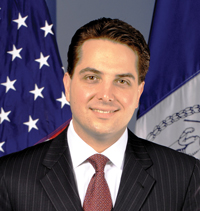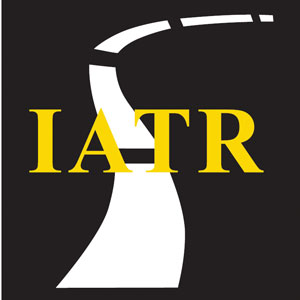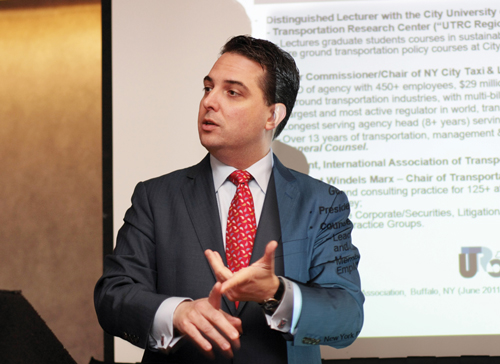 IATR — IN FOCUS
IATR — IN FOCUSPresident, International Association
of Transportation Regulators
Distinguished Lecturer, University Transportation Research Center, Region 2
Contact: mwdaus@juno.com


 IATR — IN FOCUS IATR — IN FOCUS |
||
| by Matthew W. Daus, Esq. President, International Association of Transportation Regulators Distinguished Lecturer, University Transportation Research Center, Region 2 Contact: mwdaus@juno.com |
 |
 |
Daus Speaks at New York Public Transit Association: Unveils New "Parataxi" Transportation Service to Reform Access-A-Ride and Paratransit Systems Worldwide
I am very pleased and honored to have been invited to speak at the New York Public Transit Association (NYPTA) conference in Buffalo, New York this June. I delivered a presentation on a new concept we have dubbed "Parataxis", along with my colleague and co-author Dr. James Cooper from Napier University in Scotland on behalf of the IATR (International Association of Transportation Regulators), UTRC (University Transportation Research Center, Region 2), the Transportation Research Board (TRB) and the Taxi Research Network.
NYPTA is an organization of government and quasi-government public transit agencies and authorities which educates public servants and industry vendors on best practices and innovative methods to deliver safe and efficient transportation services similar to the IATR's mission involving taxi
regulation. The theme of this NYPTA conference was "Collaborative, Collective Cost Cutting" and the title of our presentation is "Maintaining and Improving Rural Transit Supply in an Era of Cost Cutting: Parataxis - Intermodal Solutions for Rural Communities and Beyond."
The theory behind our presentation and the paper we are authoring and presenting before the Transportation Research Board of the National Research Council and the National Academy of Sciences next January is:
To use taxicabs and for-hire vehicles to deliver more efficient, accessible, environmentally sustainable and safe transportation at significantly reduced government subsidy costs while enhancing service for both disabled and non-disabled passengers in rural and urban communities throughout the United States and the United Kingdom.
There are three types of paratransit services that include mandated public subsidized accessible transportation programs such as Access-A-Ride in NY City, non-emergency medical transportation subsidized by social service funding or government programs (e.g., Medicare), and a variety of Federal Transit Administration (FTA), state and locally funded programs to provide wheelchair accessible service in a variety of ways, e.g., non-profits, private taxi companies, local government vehicles, etc. Most of these systems throughout the U.S. involve vans or shuttle buses which are designed to accommodate several disabled passengers including wheelchair users that use "bus-like" vehicles which provide non-fixed route prearranged service.
We must start by acknowledging that the Access-A-Ride and paratransit system is broken, and in fact, was inherently flawed from its inception; being inefficient by design and continuing to waste billions of dollars nationwide each year in subsidized funding. Prearranging service for multiple passengers on non-fixed routes dramatically increases travel and waiting times for disabled customers and senior citizens making for a system with inconsistent and erratic service due to unpredictable usage and the juggling of varied destinations. Also, one could argue that the spirit of "equivalent service" as envisioned by the Americans with Disabilities Act and U.S. Department of Transportation regulations is not being met as non-disabled passengers can board mass transit on demand while disabled passengers must make reservations days in advance. This inequity is compounded by the drastic service reductions taking place due to government funding issues caused by the Great Recession and other variables.

The system needs to be dramatically reformed and reengineered, and there is no better time than now to do so to address the fiscal crises public transit agencies are facing around the country. The key is to create a new transportation paradigm by phasing in "Parataxis", private taxicabs that would receive government subsidies to retrofit smaller minivans with wheelchair ramps and cover other costs such as training and increased insurance premiums to operate via a centralized dispatch system. My vision for a "Parataxi" system is to phase out paratransit vans or shuttles so that individualized prearranged for-hire or taxi service can be provided through a centralized dispatch system using Global Positioning Systems (GPS).
Rather than disjointed and uncoordinated funding, the Federal government should consolidate all disabled transport funding streams, mass transit, social services and other ancillary discretionary grants and "New Freedom" lines to require recipient States to designate only "one" agency to coordinate all services for both public transit and non-emergency medical transport by using wheelchair accessible and standard taxicabs. Service would improve in terms of reduced travel time and government costs would be significantly reduced. In addition, the Federal government could require such vehicles to be alternatively fueled or environmentally sustainable and to be operated in accordance with standards to ensure savings and efficiency to be monitored closely by a State Transportation Agency as part of its mandated planning processes.
Once we get over the government agency turf wars and resistance to change from existing van manufacturers and service providers everyone can become part of the solution in terms of still being economically viable and saving money. This solution could involve private contractors to provide centralized dispatch services and the subsidies would instead go to dispatch companies as well as private taxi businesses to offset vehicle retrofitting costs for wheelchair ramp installation, insurance and training costs. Not only does this benefit urban environments, but such subsidies would have the result of adding taxi service to rural environments where additional taxicabs will enhance sorely needed intermodal transit for all passengers across more expansive geographic territories.
Similar programs are being piloted in New York City as we speak which have elements of a total "Parataxi" solution. When I was Taxi and Limousine Commissioner in New York City several years ago I learned that the Metropolitan Transportation Authority (MTA) had contracts with a value of more than $60 million with limousine companies to pick up passengers stranded by Access-A-Ride appointments. I had a meeting with my friend and then MTA Chief Executive Officer Lee Sander and we both put the ball in motion culminating in today's Manhattan pilot program where disabled Access-A-Ride subscription service users can use debit cards issued by the MTA to use yellow taxicabs instantly via street hail. This cuts the cost per trip down from about $50-60 per van ride to around $15-20 per taxi ride. We combined the successful T-PEP program elements with the 311 dispatch system and the "Parataxi" concept and now I am pleased to learn that one of the largest and most successful car service conglomerates – Corporate Transportation Group – will be serving as the lead dispatcher to use livery vehicles in the "other boroughs" of the City in the next few months to expand this pilot program to everyone in New York City.
This is just the beginning of what I know will be a paradigm shift that will not only transform taxi service and public transit for the disabled, but will also finally bring private taxicabs into the realm of mainstream public transportation planning, research and funding. I am pleased to announce that in addition to presenting this paper to the TRB, Dr. Cooper and I will be conducting a complete session on this topic at the upcoming IATR conference in Toronto from September 11 – 14. For more information on how to register and attend the conference or become a member of IATR, visit www.iatr.org.
